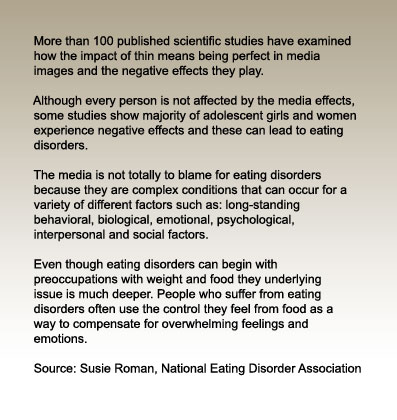
By Lauren Muskett
12/12/10
Women are becoming more vocal over the often unrealistic images of women found in advertising. And they are having some impact.
"It's a cultural phenomenon to make a difference in advertising. Advertisers are taking a step back and it's really great," said Emme, the first plus-size model in the U.S.and founder of the Body Image Council. "Now girls and women can use their voice for good. They can contact advertisers, write them and let them know what they think."
Emme said she believes if every advertising group is bombarded with e-mails and calls about the misrepresentation of women in advertising they will have to take on the issue of body image.
"Self image, body image it hits a nerve and has to be balanced in the mix," said Emme.
The National Eating Disorder Association cites estimates that show the average person is exposed to some 3,000 advertisements a day, which can lead to a negative body image in both men and women.
"Advertising impacts body image, but it is a complex thing that involves biological, psychological and social factors," said Susie Roman of the National Eating Disorder Association. "It is certainly a contributing factor and is impacted by media because people see what they should look like to be valued as a member of our society and it leads to eating disorders. Our cultural context values people who are thin and 80 percent of American women are dissatisfied with their appearance."
Advertising and media target college students and the influence from their peers can weigh heavily on their views on body image, said Roman.
"College-age women are a huge demographic because they are concentrated with their peers and are exposed to more media messaging. The media targets them," said Roman. "Dieting is unhealthy and colleges should require resources to help."
Jenna Cannava is a 21-year-old Boston area college student and she feels the body image advertising portrays makes her question her body.
"You see perfect bodies on TV and in magazines," said Cannava, "and people like me who look at that stuff, it influences me and I just can't not pay attention."
Cannava noted she knows there is no such thing as perfect, but having the images in your face all the time makes you question and want to change parts of your body.
 "I want the Heidi Montag," said Cannava of the reality TV star who is best known for going under the knife to receive 10 procedures in one day. "Even if you are happy with yourself, you are paying attention to advertising or the media who tell you what to look like or you see other girls and see people who look better."
"I want the Heidi Montag," said Cannava of the reality TV star who is best known for going under the knife to receive 10 procedures in one day. "Even if you are happy with yourself, you are paying attention to advertising or the media who tell you what to look like or you see other girls and see people who look better."
No one is immune to cultural messages in media, and people are vulnerable, Roman said.
"Advertising doesn't show the average woman," said Emme. "You have models who are unrealistically thin, women who are size 12 to 16 are beautiful and can be high end models, they are inspirational. There are 62 million women who are size 12 and above."
For the first time this fall, the plus-size fashion industry was represented during New York's Fashion Week by having a plus-size fashion show, which is a step towards embracing change and representing the average woman, said Emme.
"It's really awesome. A celebratory big surprise," said Emme. "The girls were all classy and they looked incredible. There was press from all over the world, but what is interesting is Onestopplus.com, a plus-size clothing website, was not invited to any other shows."
Emme has said the fashion industry has needed more diversity since 1992 and the tipping point was the rise of anorexia.
Most people think of the Dove campaign when they think of advertising for the average woman, but Emme noted that Dove spent $47 million in advertising and it didn't make as much money as was expected.
"One image is not a bouquet of beauty, said Emme. "If we lived in a world with one flower and that was it, it would be sad. When you bring in a bouquet of flowers is when everything becomes beautiful."
Cannava agreed that the media needs to represent all women instead of focusing on the minority of women.
"Diversity in advertising would help all women," said Cannava. "Having to see the same image all the time makes you feel like that is what you're supposed to look like. All you see is women who are skinny. So skinny, and they all have big boobs and an ass, all of them. It makes me realize what I don't have. It is unhealthy and makes you feel bad about your own body."
The whole philosophy that women should say what they want to see in advertising is a truth, half truth market, said Emme. Women are told to feel good about aging, but they rarely show older women advertising the youth creams or beauty products, she said..
"Women are getting older, but fabulous, but showing older women does not increase sales," said Emme. "You are old and want to look younger. It's the whole 'hope in a jar' element to reach for."
But Emme noted that "people are waking up." She added, "image does influence and how youth feels. It's like walking into a hurricane.
"The Internet is helping women and kids find their voices and they can tell advertisers what doesn't make them feel good. If more people use their voice things will change."
Leave a comment